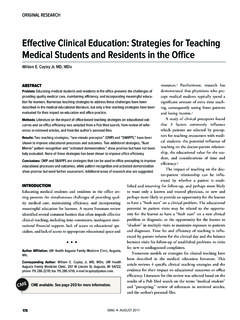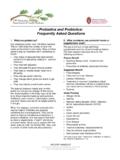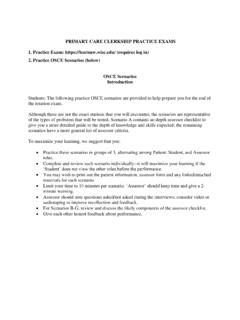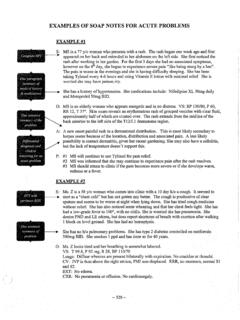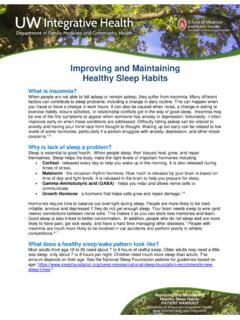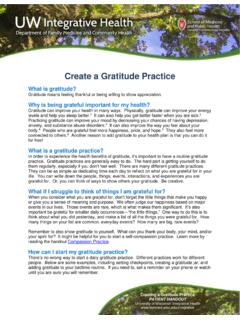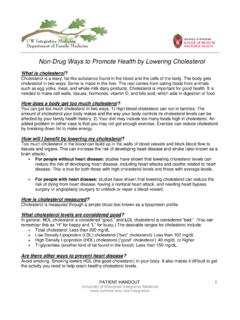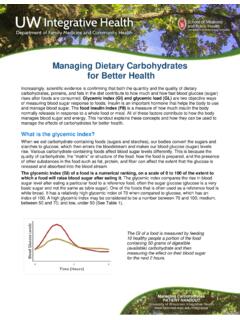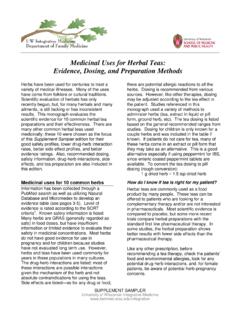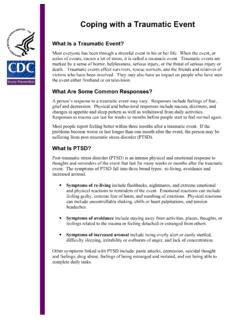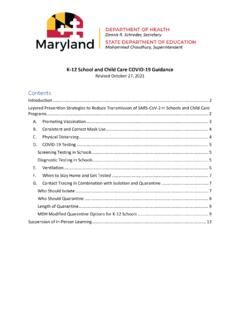Transcription of The Elimination Diet - UW Family Medicine & Community …
1 1 Elimination diet PATIENT HANDOUT University of Wisconsin Integrative Health The Elimination diet An Elimination diet is an eating plan that omits a food or group of foods believed to cause an adverse food reaction, often referred to as a food intolerance. By removing certain foods for a period of time and then reintroducing them during a challenge period, you can learn which foods are causing symptoms or making them worse. We often think of reactions to food as being a rapid allergic reaction, such as when a person has an anaphylactic reaction to eating peanuts and their throat swells up. However, there are other ways our bodies can react to foods that may not be so immediate, and may or may not be tied to an immune system response. Food intolerances may be triggered by various natural compounds found in foods (natural sugars or proteins) or common food additives (such as natural and artificial colors, preservatives, antioxidants, and flavor enhancers) that can cause reactions through various mechanisms in the body.
2 There is currently dispute about the specific mechanisms involved in different reactions to foods, and many tests to identify the suspected culprit(s) can be unreliable. Clinical experience has shown that an Elimination diet is one of the best tools for identifying food culprits and is very safe, as long a variety of foods are still eaten supplying all the essential nutrients. Symptoms Symptoms of food intolerance can vary widely. They can include stomach and bowel irritation, headaches, hives, itching, and even vague feelings of being unwell, such as flu-like aches and pains, unusual tiredness, or concentration problems. Certain foods and food groups are also known to exacerbate symptoms in people with specific conditions such as autoimmune disorders, migraines, Irritable Bowel Syndrome, gastroesophageal reflux (GERD) and Symptoms and their severity are unique to the individual. They are influenced by specific compounds in the food, a person s sensitivity level, and how much of certain foods are eaten.
3 If the same food is eaten repeatedly, or different foods with the same compound are eaten together or often, the body may reach a threshold, or a tipping point where symptoms begin to occur. Natural Food Substances Even healthy foods contain many different naturally occurring chemicals that can be a problem for some people. Substances common to many different foods, such as salicylates, amines, and glutamate, may cause symptoms for different individuals. It is beyond the scope of this handout to provide detail about the different categories of natural substances that may cause symptoms, but this can be explored with a practitioner who is comfortable working with Elimination diets (not all practitioners are). Individual Variation Because people are unique genetically, and because we each have different eating patterns, Elimination diets have to be based on each unique individual. Eliminating the most offending food or multiple foods and substances all at one time is the most reliable way to find out which foods may be contributing to symptoms.
4 A healthcare practitioner may recommend a specific plan to follow based on symptoms, typical dietary choices, and food cravings. 2 Elimination diet PATIENT HANDOUT University of Wisconsin Integrative Health There are four main steps to an Elimination diet : Step 1 Planning Work with your health care practitioner to learn which foods might be causing problems. You may be asked to keep a diet journal for a week, listing the foods you eat and keeping track of the symptoms you have throughout the day. See the last page of this handout for a Food Diary Chart you can use. It is helpful to ask yourself a few key questions: What foods do I eat most often? What foods do I crave? What foods do I eat to feel better ? What foods would I have trouble giving up? Often, these seem to be the foods that are most important to try not to eat. Also, see Table 1 for a list of the most common problem foods.
5 Make a list of potential problem foods. The Elimination diet can vary in intensity depending on how many suspected food culprits are being avoided. Three different levels of food Elimination can be followed depending on suspected food culprits and likelihood of adhering to the diet . The three levels are described below in the Elimination diet Strategies section on page 6. It is helpful to think about choosing the strategy that is the least restrictive first in order to maximize successful adherence to the restrictions. However, the more restrictive strategies are more effective at identifying cases where there are multiple food culprits. Are You Ready? Before starting an Elimination diet , it is important to consider whether this is a good time to undertake these potentially large changes in diet . Do you have any upcoming stressful life events or travel? Do you have the resources, willingness, and energy to create new grocery lists and menus to cook new recipes?
6 Do you have support from Family and friends for eating at home, at work, or out at restaurants and other events? It will be important to completely eliminate the foods on your list for 2-4 weeks, so if you accidentally eat one of the foods, you will need to start again. It will be quicker and easier if you are successful the first time. Step 2 Avoiding Make a list of foods to avoid based on your planning, and be sure of how to avoid possible hidden foods (See Table 3 Hidden Foods). Begin the Elimination diet and for two to four weeks, follow the Elimination diet without any exceptions. Don t eat the eliminated foods whole or as ingredients in other foods. For example, if you are avoiding all dairy products, you need to check labels for whey, casein, and lactose so you can avoid them as well. This The Elimination diet Steps 3 Elimination diet PATIENT HANDOUT University of Wisconsin Integrative Health step takes a lot of discipline.
7 You must pay close attention to food labels. Be particularly careful if you are eating out, since you have less control over what goes into the food you eat. If you make a mistake and eat something on the list, you should start over. Many people notice that in the first week, especially in the first few days, their symptoms will become worse before they start to improve. If your symptoms become severe or increase for more than a day or two, consult your health care practitioner. Table 1 Common Culprits for Food Allergy and Intolerance Step 3 Challenging If your symptoms have not improved in two weeks, continue for up to four weeks. If your symptoms have not improved by the end of four weeks, stop the diet and explore whether or not to try this process again with a different combination of foods. You should be symptom -free for at least 5 days before beginning your food challenges. If your symptoms have improved, start challenging your body with the eliminated foods, one food at a time.
8 As you do this, use the Food Diary at the end of this document to keep a written record of your symptoms. To challenge your body, add a new food back in every three days. It takes three days to be sure that your symptoms have time to come back if they are going to. It is suggested that you eat a small amount on day 1 of re-introduction, have about twice the amount on day two, and then an even larger portion on day 3. See Table 2 for a sample calendar. It is important to note that some foods Common Food and Food Component Culprits Foods Additives and Natural Compounds Citrus Antioxidants (butylated hydroxyanisole and hydroxytoluene) Dairy Products Aspartame (NutraSweet, an artificial sweetener) Eggs Flavor enhancers (monosodium glutamate) Gluten (barley, oats, rye, and wheat) Artificial Food Colors (tartrazine and other Food Dye and Coloring Act [FD&C] dyes, which are derived from coal tar) Soy Lactose and other disaccharides Peanuts Nitrate and nitrites (found in preserved meats) Shellfish Preservatives (sulfites, benzoates, and sorbates) Tree Nuts Thickeners/stabilizers (tragacanth, agar-agar) Beef products Biogenic amines (histamine, tyramine, octopamine, and phenylethylamine)
9 Corn Salicylates naturally occurring compounds found in many fruits, vegetables, some cheeses, herbs, spices, nuts, and medications such as aspirin Refined sugars (depends on source of sugar) NOTE: If a food causes you to have an immediate allergic reaction, such as throat swelling, a severe rash, or other severe allergy symptoms, seek medical care and avoid food challenges unless you are directly supervised by a physician. 4 Elimination diet PATIENT HANDOUT University of Wisconsin Integrative Health may be tolerated in small amounts, but not larger amounts. Keeping a careful food diary can be very helpful in identifying these foods. It is important to test with the purest form of food available. For example, to test wheat, use a pure wheat cereal that contains only wheat. You may use a non-dairy milk substitute like rice or other milk as long as that milk is not on your avoid list.
10 Test milk and cheese on separate occasions. Different cheeses may be differently reactive or not, so best to test on separate occasions. Usually yogurt, cottage cheese, and butter do not need to be tested separately. For eggs, test the whites and yolks separately using hard-boiled eggs. Food challenges should be done as systematically as possible. Some components of foods, such as the proteins casein and whey, and the sugar lactose in dairy can be systematically isolated by careful challenge planning. If you suspect a specific component of a food may be a culprit, try to work with a knowledgeable healthcare practitioner who can help you develop your plan. However, if you eliminate an entire food group, it may only be necessary to challenge with one or a few different foods from that group, not every unique food. As soon as a symptom returns, remove the food from the diet , make a note in the food diary and place that food on the allergic list.
